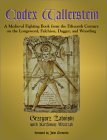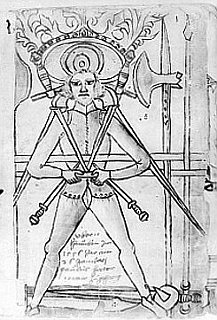 Book Review: Codex Wallerstein
Book Review: Codex Wallerstein 
 Book Review: Codex Wallerstein Book Review: Codex Wallerstein  |
 |
Title: "Codex Wallerstein: A Medieval Fighting Book from the Fifteenth Century on the Longsword, Falchion, Dagger, and Wrestling" Publisher: Paladin Press, July 2002 Author: Grzegorz Zabinski, Bartlomiej Walczak Reviewer: David M. Cvet |
 Anyone who is about to enter the world of historical European martial arts today are the most fortunate with respect to the increasing availability of English translated and interpreted historical manuscripts that describe these fighting arts. Practitioners who currently study the historical manuscripts, slogging away at Middle High German, medieval Italian or Latin now find relief with publications such as this. Anyone who is about to enter the world of historical European martial arts today are the most fortunate with respect to the increasing availability of English translated and interpreted historical manuscripts that describe these fighting arts. Practitioners who currently study the historical manuscripts, slogging away at Middle High German, medieval Italian or Latin now find relief with publications such as this.
The Codex Wallerstein is one of the most comprehensive manuscripts depicting early European martial arts. Written in high middle German during the late 14th century and early 15th century, the codex has remained in obscurity for generations at the Augsburg University (I.6.40.2) available to only the local scholars for study and research purposes. The manuscript or fechtbuch is comprised of 221 pages, which contains predominantly illustrations depicting the various fighting techniques along with text above the illustrations. The codex appears to be comprised of to different manuscripts which seems to have been put together at a later date from its original creation. This is supported in evidence by the style of garments and the arms and armour that provide clues as to when the two parts were created. The fechtbuch's part "A" of 151 pages is comprised principally of illustrations, begins with illustrations describing a judicial armoured duel, followed by more illustrations depicting unarmoured longsword techniques (blossfechten), wrestling/grappling (ringen), unarmoured dagger (degen), unarmoured falchion (messer) and lastly, an interesting illustration and "advice" on "how to rob a peasant with a knife". Part "B" comprised of 66 pages includes illustrations and text describing unarmoured longsword techniques (blossfechten), armoured combat techniques (harnischfechten), a judicial duel with shields, maces and swords and lastly, wrestling or grappling (ringen) followed by a presentation of individuals in courtly garments of the period. The fechtbuch was interpreted and translated by the principle author, Grzegorz Zabinski with the assistance from Bartlomiej Walczak. Mr. Zabinski is a medievalist from Upper Silesia in Poland. He is currently working on a Ph.D. dissertation on early 16th century comments on the swordsmanship treatise of Johannes Liechtenauer. Mr. Walczak is a student of physics, but his real passion is the study of medieval martial arts. A brilliant academic effort by the authors who enhance the credibility of the work by including not only the English translated text, but the original Middle High German text of the period. This publication is a "must have", invaluable resource for any practitioner's reference library interested in the study and practice of German historical European martial arts. August 2002 |
|
Copyright © 2002 Academy of European Medieval Martial Arts AEMMA |
|